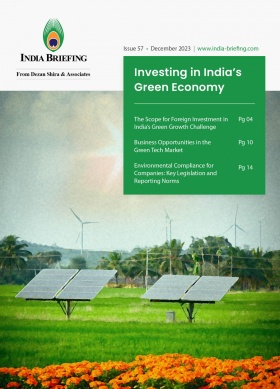India’s Regulation of Solar PV Modules: Approved List of Models and Manufacturers
While India has relaxed regulations concerning solar PV module imports for a one-year period for certain projects, the Approved List of Models and Manufacturers (ALMM) mandate will be used by the government to promote domestic manufacturing capabilities and ease imports in the mid-to-long-term.
With effect from April 1, 2024, India has revived the Approved List of Models and Manufacturers (ALMM) mandate. Analysts have characterized this move as favorable news for the country’s solar Original Equipment Manufacturers (OEMs).
However, for a certain period of time, captive and open-access solar projects will be excluded from the ALMM, enabling them to purchase modules from suppliers offering the best prices.
At present, importing solar PV modules is comparatively more cost-effective than sourcing from domestic OEMs, despite high import duties.
Webinar – India’s Top 5 Investment Destinations: Strengths and Opportunities for Foreign Businesses
Thursday, May 16, 2024 | 12:00 PM New York / 6:00 PM Brussels
Kyle Freeman, Partner at Dezan Shira & Associates, will introduce the top 5 most promising investment locations in India, providing an overview of their strategic strengths, factors driving their growth and highlight opportunities for foreign investment.
Join us in this free webinar.
What is the ‘Approved List of Models and Manufacturers’ mandate?
Launched by India’s Ministry of New and Renewable Energy (MNRE) in 2019, the Approved List of Models and Manufacturers comprises of LIST-I, which outlines models and manufacturers of solar PV modules.
A second list, LIST-II, which specifies models and manufacturers of solar PV cells, has not yet been issued.
Only solar PV models and module manufacturers listed on the ALMM are permissible for use in government-sponsored or subsidized solar projects in India.
Time-bound exemption
In response to concerns regarding insufficient supply of domestically manufactured modules to meet growing demand, the MNRE suspended the ALMM mandate in March 2023.
Projects commissioned by the end of March 2024 will be exempt from the requirement of procuring solar PV modules from the ALMM list.
What is the benchmark to become eligible for ALMM?
|
Category |
Application/Use |
Minimum module efficiency required to be eligible for enlistment in ALMM for solar PV modules |
|
|
|
|
For crystalline silicone technology based solar-PV Modules |
For cadmium telluride Thin Film technology based solar PV modules |
|
Category-I |
Utility / Grid Scale Power Plants |
20% |
19% |
|
Category-II |
Rooftop and Solar Pumping |
19.50% |
18.50% |
|
Category-III |
Solar Lighting |
19% |
18% |
The MNRE categorizes Cadmium telluride (CdTe) thin-film modules under ALMM into three segments: utility or grid-scale power plants, rooftop and solar pumping, and solar lighting.
As per the latest ALMM mandate, India has opted for a one-year relaxation period for now.
The ALMM mandate was introduced in 2021 as a non-tariff barrier and aims to promote domestic manufacturing by endorsing indigenous models and manufacturers to be eligible to participate in government-led solar development projects. Subsequently, the mandate was extended to encompass the government’s open-access projects as well.
Tracking domestic production of PV modules in India
In April, reports surfaced indicating that the central government plans to introduce an online repository for all solar modules manufactured in India. Each domestically produced module will receive a unique identification number upon registration on the platform.
Bhupinder Singh Bhalla, the secretary for the Union Ministry of New and Renewable Energy, stated that the prototype has already undergone a six-month development process with industry collaboration and is anticipated to be launched within two months.
The announcement comes at a time when manufacturers are struggling to compete with continued imports of modules, despite a steep import duty of 40 percent, owing to shortages and higher prices of domestic modules.
The secretary emphasized that the reinstatement of the ALMM would help address concerns regarding escalating imports over time. The domestic ecosystem is also equipped to accommodate projects, with approximately 37 GW already committed under the ALMM.
India’s renewable energy goals
The emphasis on domestic module manufacturing and reduced dependence on imports align with India’s ambitious goal of achieving 500 GW of installed renewable energy capacity by 2030. In addition to imposing higher basic customs duties and the ALMM to curtail imports, a production-linked incentive (PLI) scheme is also in progress to encourage local manufacturing of these modules.
According to data from ICRA, India’s cell and module imports during the April-February period of FY24 amounted to INR 419.2 billion (approx. US$5.03 billion), significantly higher than INR 180.93 billion (approx. US$2.17 billion) in FY23. This surge in imports in the recently concluded fiscal year can be attributed to the relaxation of ALMM norms for a year.
Vikram V, Vice President and Co-Group Head of Corporate Ratings at ICRA, highlighted that the proposed mechanism would aid in ensuring compliance with regulations for domestic content usage.
Meanwhile, Girishkumar Kadam, Senior Vice President & Group Head, told the media that the scale-up in domestic module manufacturing capacity over the past 12 months is expected to improve the availability of modules from domestic OEMs. However, the sector would remain dependent on imports for sourcing solar PV cells and wafers, given the limited cell manufacturing capacity and lack of wafer capacity in India. In this context, setting up fully integrated units awarded under the PLI program remains important to reduce dependence on imports.
Outlook
As per a NASDAQ report, India ranked fifth globally in solar power capacity, boasting a cumulative installed capacity of 62.80 GW by the close of 2022, a notable increase from 49.34 GW in 2021. As of June 30, 2023, the solar power installed capacity had surged to approximately 70.10 GW.
India’s initial PV installed capacity was 14.46 GW in 2013. In April 2023, India unveiled plans to annually add 50 GW of renewable energy capacity, encompassing solar, wind, hydro, and bio, over the next five years, aiming to achieve a target of 500 GW by 2030. Presently, the country’s total renewable energy capacity stands at 168.96 GW based on recent estimates.
Projections suggest that India’s solar market is poised to expand to 195.11 GW in the next five years, exhibiting a Compound Annual Growth Rate (CAGR) of 19.8 percent during the forecast period. As part of its updated Nationally Determined Contribution (NDC) under the Paris Agreement, India has committed to reducing the emissions intensity of its GDP by 45 percent by 2030 from 2005 levels and to achieve approximately 50 percent of its cumulative electric power installed capacity from non-fossil fuel-based energy sources by 2030. This updated NDC aligns with India’s long-term goal of achieving net-zero emissions by 2070.
(US$ 1= INR 83.30)
About Us
India Briefing is one of five regional publications under the Asia Briefing brand. It is supported by Dezan Shira & Associates, a pan-Asia, multi-disciplinary professional services firm that assists foreign investors throughout Asia, including through offices in Delhi, Mumbai, and Bengaluru in India. Readers may write to india@dezshira.com for support on doing business in India. For a complimentary subscription to India Briefing’s content products, please click here.
Dezan Shira & Associates also maintains offices or has alliance partners assisting foreign investors in China, Hong Kong SAR, Dubai (UAE), Indonesia, Singapore, Vietnam, Philippines, Malaysia, Thailand, Bangladesh, Italy, Germany, the United States, and Australia.
- Previous Article India’s Dedicated Freight Corridor Program: Progress and Prospects
- Next Article The MedTech Industry in India: Outlook and Growth Drivers








